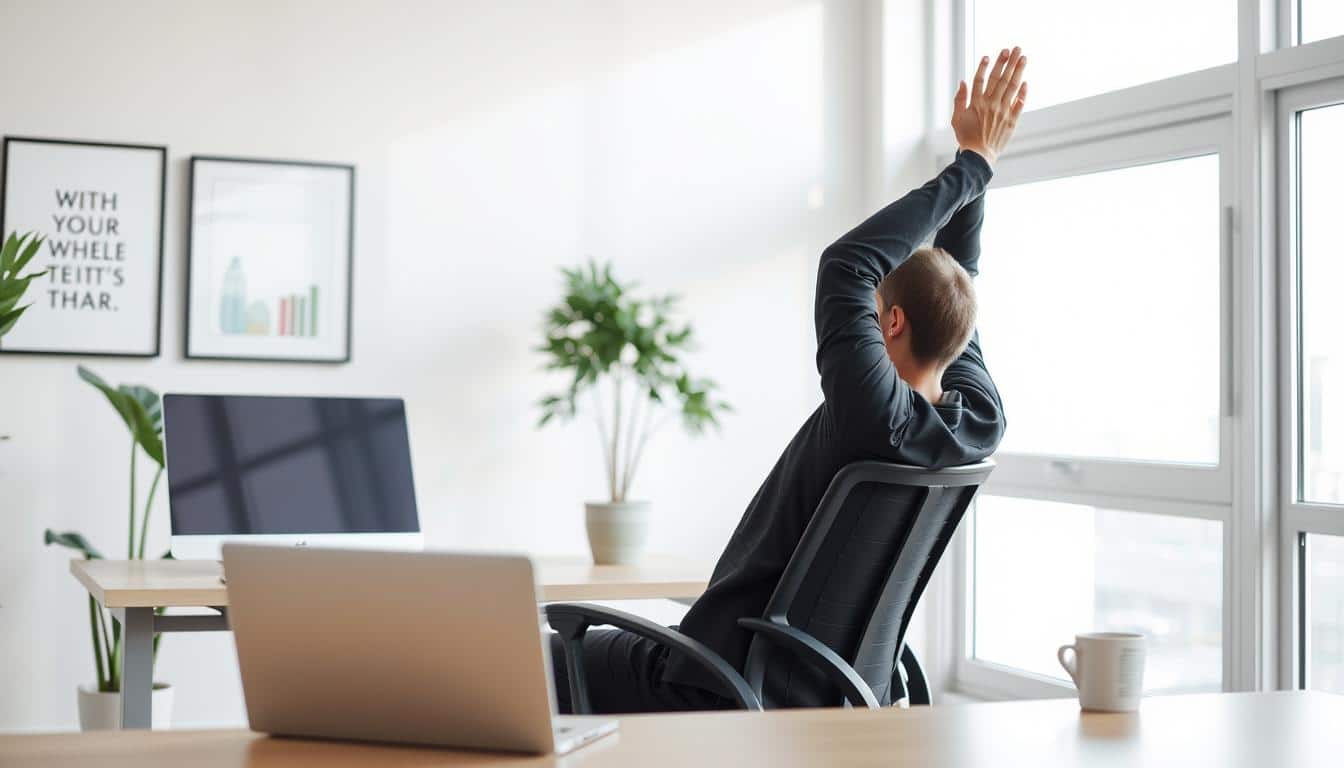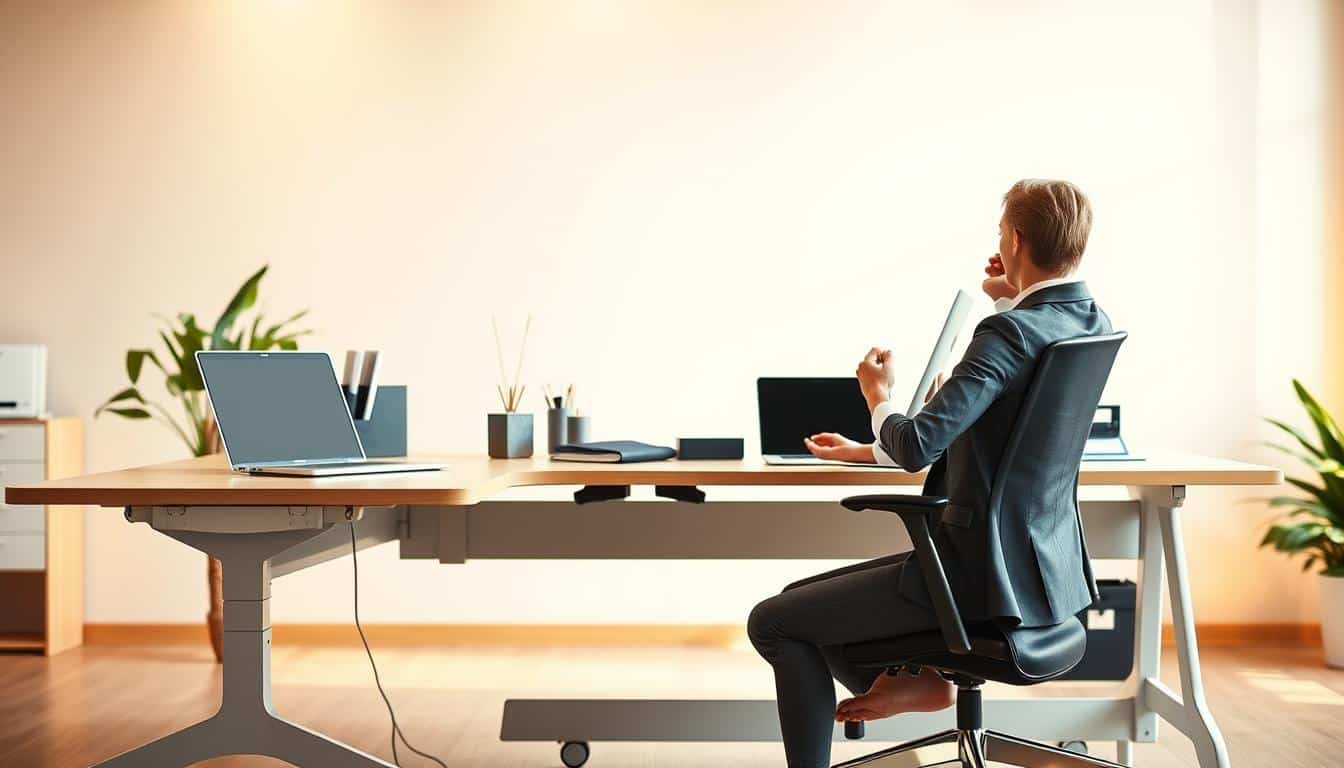Today’s work life moves fast, and active sitting is key for better health at the office. With more people working from home, sitting all day has become common. This can lead to health problems. Active sitting brings movement into your day, boosting both productivity and well-being.
Chairs for active sitting like wobble stools and balance balls make you move a little all the time. They make your core and back muscles work gently. This keeps you from getting stiff, boosts blood flow, and helps you keep good posture easily. You end up burning more calories, feeling better, and your spine stays aligned.
Using ergonomic chairs means less back pain and more flexible joints. Active sitting chairs help keep your upper body steady and let your hips move. They’re better than regular office chairs. Try active sitting and see how it changes your time at the desk.
The Importance of Movement While Sitting
It’s vital to move around, even when sitting, to stay healthy. Sitting for too long can hurt our health. Being inactive for long periods can lead to obesity, diabetes, and heart problems. Our bodies need to move. Staying in one place can cause bad posture, muscle stiffness, and other health issues.
Understanding the Impact of Prolonged Sitting
Sitting too much is bad for our bodies. Many people sit for about nine hours a day, doing things like computer work or watching TV. This can lead to Upper Cross Syndrome (UCS), causing pain in the back, neck, and shoulders. It might even cause headaches and stiffness. Using a standing desk can help by changing how you work.
Health Risks Linked to Sedentary Lifestyles
Being inactive has big health risks. Sitting a lot increases the risk of getting fat, some cancers, and dying early. Studies show bus drivers who sit a lot have twice the risk of heart attacks. Moving more, like walking or stretching, helps reduce these risks. It keeps you more fit and less tired.
Try walking a bit every thirty minutes and aim for daily activity goals. Doing light activities fights the downsides of sitting too much. It improves heart health, muscles, and overall happiness.
Active Sitting Defined
Active sitting, or dynamic sitting, changes the way we use chairs. It encourages movement while you work. Instead of staying still, it makes you use your muscles and stay comfortable. While old-style chairs make you sit without moving, active sitting brings in chairs that keep you moving lightly. These small movements are key to the benefits of active sitting.
What is Active Sitting?
Active sitting means chairs that make you move. It’s not new; think of rocking chairs or stability balls. Take the QOR360 Ariel, with its full-circle rocking. It helps you sit straight. Or the Branch Saddle Chair, with its tilted seat for leg support and height adjustments for various sitting styles. There’s also the Humanscale Freedom Saddle/Active Pony, blending comfort with a rocking feature.
How Active Sitting Differs from Traditional Sitting
Standard chairs can make you stiff and lead to back pain and poor blood flow. But active sitting keeps you stable and your muscles working. It helps your blood move better and prevents problems from staying in one pose. Unlike sitting still, which can weaken muscles over time, active sitting fights these problems. It sets the base for a healthier, active way of living.
Benefits of Active Sitting
Active sitting changes how people work at their desks. It improves physical health and brain power in many ways.
Boosting Energy and Focus
Active sitting boosts energy. It makes you move more and improves muscle activity. This keeps you energized all day.
It also makes your blood flow better. This sends more oxygen and nutrients to your brain, making you more focused and clear-headed.
Improving Posture and Reducing Pain
Active sitting makes your posture better. People notice their spine aligning more naturally. This reduces back and neck strain.
Better posture means less pain from sitting too long. This lets people work comfortably for longer times.
Enhancing Circulation and Core Engagement
Active sitting is good for your core. Active chairs encourage movement and support your back. This leads to better circulation and stronger core muscles.
With a strong core, you have better stability and movement. Over time, active sitting can improve your health and work performance.
Active Sitting Chair Options
Finding the right active chair can make a big difference in how you feel and work. There are many kinds of active chairs, each designed for certain needs and office set-ups. A good guide can help you pick the one that offers both movement and support, making your sitting time better.
Types of Active Chairs
There are many types of active chairs for different uses and spaces. Let’s look at some popular ones:
- Tilting Chairs: Made by HAG, 9to5 Seating, and Eurotech, these chairs allow you to shift position without losing their classic look.
- Capisco Chair: Created by Peter Opsvik, this chair has a saddle seat and supports various sitting styles, and it’s great with desks that adjust from sitting to standing.
- Kneeling Chairs: Also by Peter Opsvik and offered by Varier, they help your spine stay aligned and reduce pressure.
- Saddle Chairs: Salli provides these chairs, promoting an upright position and letting you move freely.
- Sway Chairs: Corechair offers these chairs, blending motion flexibility with a cozy seat design.
- Perch Stools: From Varier and Corechair, these stools activate your core muscles, offering a mix of sitting and standing.
- Ball Chairs: Venn Design’s chairs are dynamic, focusing on core strength and fitting a range of activities.
How to Choose the Right Active Chair for You
When selecting an active chair, keeping a few factors in mind is key. It should match your personal and workspace needs. Here are some tips to help choose the right one:
- Height Adjustability: Make sure the chair can be adjusted to match both your body size and your desk height.
- Comfort Levels: It’s vital to find a chair that remains comfortable over long periods. Try out several models if possible.
- Mobility Degree: Think about how much you want to move in the chair and if it suits your way of working.
- Compatibility with Office Furniture: The chair should fit well with your office setup and desk height to prevent discomfort.
Incorporating Active Sitting into Your Day
Integrating active sitting into your daily life boosts your well-being. Include simple seated exercises and create a workspace for movement. This will make your workplace healthier.
These methods engage your muscles. They help you stay active, even when you sit at a desk.
Simple Seated Exercises to Try
Active sitting works well with a mix of seated activities during work. Here are some exercises to try:
- Leg lifts to activate your lower body.
- Seated marches to promote circulation.
- Neck stretches to relieve tension.
- 30-second stretching sessions, such as touching your toes or performing jumping jacks.
- Creative movements like mimicking the alphabet with your body while seated.
These activities keep your muscles working. They also offer a break from sitting too long.
Creating a Movement-Friendly Workspace
Design a workspace that encourages moving around. Here’s how:
- Position frequently used items just out of reach to promote standing up.
- Utilize standing desks or alternate between sitting and standing during tasks.
- Incorporate an under-desk elliptical for light exercise during less demanding tasks.
- Opt for stairs instead of elevators and park farther away to increase daily movement.
- Engage in walking meetings to combine productivity with physical activity.
These steps support good posture. They also boost your energy during the workday.
Adjusting Posture Regularly
Making sure you change your posture often is key for good health and productivity when sitting for long hours. Staying still can cause stiffness and discomfort. Knowing the benefits of changing positions helps your overall health. Using good posture adjustment methods can really help you feel better every day.
Importance of Frequent Position Changes
Switching your posture a lot stops the bad things that happen when you sit too much. Using different muscles helps your blood move better and reduces muscle pain. Even something simple, like shifting your weight or changing how you’re sitting, can make a big difference. These small moves are really important for keeping your spine aligned. This can help reduce pain in your neck and back.
Effective Techniques for Maintaining Good Posture
Using a few smart methods can really improve your posture:
- Towel Technique: Place a rolled towel at the lower back for lumbar support.
- Wall Squats: Press your shoulder blades and lower back against a wall while bending your knees at a 90-degree angle.
- Lunge Stretches: Step forward into a lunge position, holding for thirty seconds to loosen hip flexors.
- Rolling Feet: Use a foot massager or a frozen water bottle to prevent plantar fasciitis.
- Back Extensions: Stand and gently lean backward, promoting correct seated posture.

These tips help you adjust your posture all day, creating a healthier work area. Changing your position often is key for comfort and staying productive. Trying out these different methods makes working at a desk better. It leads to a more balanced way of active sitting.
Taking Micro-Breaks for Lasting Wellness
Adding short breaks throughout your workday is key to staying well, handling stress, and avoiding burnout. These breaks, ranging from seconds to a few minutes, help sharpen your mind and focus. By stepping away from your desk periodically, you can recharge and work more efficiently.
Strategies for Effective Micro-Breaks
For the best results from short breaks, try these wellness tips:
- Engage in light stretching or walking every 20 to 30 minutes.
- Incorporate mindfulness exercises, like deep breathing or short meditations, to reset focus.
- Implement the 20-8-2 protocol, alternating between sitting, standing, and movement.
- Participate in dynamic activities, such as light exercise, during breaks to boost circulation.
Setting Reminders and Staying Consistent
Using reminders on your smartphone or computer helps remember to take breaks. Set them to alert you every 30 to 60 minutes for a quick pause. Being consistent with these breaks can increase your work performance, motivation, and overall health. Make taking short breaks a daily habit, and notice how your energy and focus levels rise.
Active Sitting: A Complementary Approach to Reduce Stress
Active sitting is a great way to cut down stress by getting you to move while you sit. It helps you relax both your body and mind. It makes you feel calm and improves your posture.
Ways Active Sitting Enhances Relaxation
There are many ways active sitting can help relax you during your workday.
- Seated Marches: This exercise keeps your core muscles active and boosts circulation.
- Shoulder Rolls: They ease tension in your shoulders and upper back, helping with stress relief.
- Seated Torso Twist: This movement makes your spine more flexible and less stiff, offering a nice break.
- Ankle Circles: Boosting leg circulation lessens tension, which helps you relax more fully.
- Desk Push-Ups: Strengthening your upper body lessens lower back pressure, making you more comfortable.
Integrating Active Sitting with Other Stress Relief Techniques
Using active sitting with other stress relief methods gives you a full wellness plan. Here are some tips:
- Set a Timer: Remind yourself to take a break and move a bit every 30 to 60 minutes.
- Modify Your Workspace: Choose chairs with good back support or use cushions to make active sitting better.
- Integrate Movement into Daily Tasks: Do seated exercises when on phone calls or in virtual meetings.
- Consult Healthcare Professionals: Make sure the exercises you do are safe for you by talking to a healthcare pro.
Conclusion
Active sitting is a great way to beat the downsides of desk jobs. By adding active sitting to our day, we feel more energetic and focused. Our posture gets better too. This summary shows that small movements can work our core, legs, and back muscles. It helps us stop slouching and feeling uncomfortable when we sit for too long.
Active sitting improves blood flow and stops stiffness. It also eases lower back pain, a big problem in today’s offices. Mixing active seating with standing breaks and stretches is smart. It helps us get used to moving more gradually.
Choosing active sitting means choosing a healthier life. Tools like wobble stools or balance ball stools offer a cool, active way to sit. They lessen the negative parts of sitting all day at a desk. Changing how we sit is good for our health. It brings positive changes in our work and personal life.



